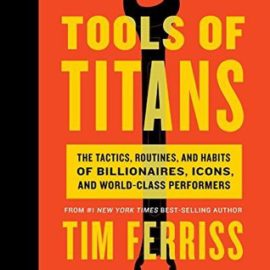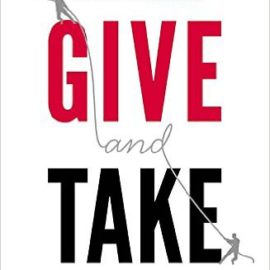
Want to get the main points of The Fifth Discipline in 20 minutes or less? Read the world’s #1 book summary of The Fifth Discipline by Peter M. Senge here.
The Fifth Discipline is a classic business book that is a must-read for anyone who wants to learn more about business strategy and organizational design. The book conveys a set of mental tools to help us better understand a complex world, and explains how we can apply them holistically in organizations that increasingly inhibit our ability to operate effectively. The Fifth Disciple itself, systems thinking, is simply that our actions create our reality. This occurs in very complex phenomena, making it difficult to understand how and why it occurs. In order to begin to understand it, we have to break free of the subtle bonds of linear thinking that restrict our minds.
The core problems that ruin organizational effectiveness start in the classrooms. People have been brought up to break down the world into discrete pieces in an education and society that overemphasizes analysis. However, overuse of this process blinds us from understanding how it fits into the whole. The sum of the parts is less than the whole, and we cannot understand the whole by adding up the sum of its parts.
Promoting Personal Mastery
Just because individuals learn doesn’t mean organizations will too, but individual learning is a prerequisite for organizational learning. Personal mastery begins with obtaining competence and skills. It encompasses not only spiritual growth, but also seeing life as a creative discipline. This change in perspective is required to stop going through life reactively, and instead approach it as proactive creative work. Otherwise, it is all too easy to keep solving problem after problem and forget about why we are solving those specific problems in the first place.
People who pursue personal mastery will go through life with a different air and outlook than others. They will naturally take the initiative, they won’t get burned out, and they will come to work each day fresh and with purpose. They focus on the most important intrinsic goals, without worrying about secondary tangible goals. They are willing to live with emotional tension that allows them to reach their creative peak. Above all, they commit to staying true to their own vision and the truth. These constraints help foster their creativity. The best way to transmit the emphasis of striving for personal mastery to others is to embody it. If others can see how one committed to personal mastery goes through life, they will be more willing to consider it for themselves.
This distinct outlook and commitment changes how people view common things. For example, failure is perceived as merely a gap between one’s vision and the current reality. At worst, it is an opportunity for learning. It is not something to be upset or feel stressed over. Thus people on the path to personal mastery have an uncommon amount of patience and perseverance: they believe time is their ally. The long-term view makes them more likely to initiative positive change before there is a crisis.
Many obstacles inhibit the promotion of personal mastery, usually related to a deficient organizational mental model. A primary obstacle organizations face in harnessing personal mastery is that it is framed as a means for the ends of the organization. But this contractual-type of mental model is not fulfilling and will prevent an organization reaching the highest level of its internal relationships. Another barrier is a type of cynicism that aiming for these flowery goals like personal mastery won’t really achieve anything. Many people have limiting beliefs that prevent them from truly mastering their lives.
Managers and organizations that emphasize quantitative measurements and hard attributes will naturally be opposed to the ‘soft’ aspect of personal mastery. A key attribute like ‘genuinely caring’ is not something that can be quantified. It is not a process one can implement and accurately measure the improvements. That is a core problem with promoting personal mastery: promoting it won’t work unless the entire organization is properly aligned to support it. If everyone from the top down and the bottom up operates in an atmosphere of commitment to the whole, they will find energy previously unavailable.
We are held prisoner by structures that we cannot perceive. For instance, the author was trapped in a pattern of powerlessness because his experience showed him that other people would let him down at crucial points. Once he was able to identify that pattern, its hold over him ceased.
The way of personal mastery is about harnessing the subconscious. This is a skill that we aren’t trained to do in many areas of life. We may have accidentally mastered skills by training the subconscious, and execute them without thinking. However, we don’t take the time to assess at a meta-level how we trained the subconscious, and how we can better connect our conscious and unconscious minds.
By paying more attention to these factors, we can better integrate seemingly disparate areas of our lives like rationality and intuition. Because intuition cannot be expressed through linear rationality, people make the mistake in assuming that it is not rational. Einstein, for instance, extolled his intuition as the fountain of all his ideas, but he was capable of rationally conveying these intuitive ideas to others. If one can reintegrate reason and intuition, they can start viewing the world holistically.
Mental Models
The best ideas in an organization are rarely implemented. This is because they usually conflict with the existing mental models of the world. Human brains filter all incoming information into a set of patterns, here labeled mental models, which assemble the information into a form we can digest. Thus we never actually see all the data we are exposed to: we see a selective portion our brain filters for us.
Mental models are a way of simplifying reality. At the start, mental models may be explicit, something we have to consciously think, hear, or observe for it to register. However, over time mental models begin to operate at a subconscious level. Hence we are blind to how our brains filter information. So long as the filtering accurately represents reality, then there is no problem. Unfortunately, our models quietly prevent us from seeing reality when the world changes. We become blind to what we are blind to.
This simple yet powerful fact has led to astonishing consequences across history. For example, physicists conducted experiments for years that contradicted the basic tenets of classical physics. However, their mental models inhibited them from seeing these contradictions, and what the contradictions actually meant. They were blind to data that would have allowed them to create the groundbreaking quantum mechanics and relativity theories.
Detroit automaker executives also were blinded by their limited mental models. Their years of experience had trained them to believe that automotive plants were supposed to look and operate a certain way. The consistent Japanese erosion of U.S. automobile market share alerted Detroit executives to the possibility that the Japanese might know something they didn’t. When the executives went to tour Japanese plants, the American executives believed that they were being shown a staged tour because Japanese plants had none of the signals that they were used to. Managers could not believe that Japanese companies like Toyota were beating their own by doing heretical things like not having any inventory lying around. These principles espoused by Detroit executives had worked for some time, but their rigid adherence to them after they no longer fit reality blinded them to innovations happening elsewhere.
(Shortform note: Fitting with Senge’s theme of holistic thinking versus pure analysis, Detroit executives were exposed to Japanese innovations piecemeal. They would try one flavor of the year, it wouldn’t work, and they would give up. However, the brilliance of companies like Toyota lay in how everything worked together holistically.)
Just as mental models can be a hindrance, they can also serve as a tool for simplifying complex chunks of reality. During the 1970’s oil crisis, Royal Dutch/Shell managers reacted differently than competitors. In the face of greater uncertainty and a looming crisis, other oil companies tightened centralized control and tried to predict the future. Instead, Shell decentralized operations, and ran managers through a series of scenarios. These scenarios helped unpack their hidden set of assumptions that were completely out of line with reality. This unpacking enabled them to create fresh mental models that were more aligned with the current turbulent situation. Because Shell operations were more decentralized, managers who updated their mental models were more quickly able to respond to the chaos around them. Put in a checklist, we can see a core set of tools to work with mental models:
- Look for distinctions between what we say and the implied reasoning behind what we do.
- Notice leaps from observation to generalization.
- Expose tacit information we don’t normally convey.
- Create a harmony between inquiry and advocacy to achieve collaborative learning.
At present, most people and organizations are dominated by linear thinking. This has its purpose, but is limited and doesn’t work in certain domains. Learning organizations in the future need to emphasize mental models based on patterns of change and shared relationships. This will allow them to create a ‘library’ of mental models for a specific organization. Our brains will always be ruled by mental models of some kind, but we can switch them from mental models of isolated events to models that encompass a more abstract level of long-term patterns of events.
Shared Vision
A shared vision is critical for an organization because it is the catalyst for the energy and focus to learn. The ultimate goal for an organization is to self-generate learning, which improves one’s ability to create. However, there is little reason for someone to value this goal unless they possess a vision they truly want to fulfill. Personal mastery is necessary for achieving our best, but a shared vision is a requirement to make it a reality.
Like this summary? Want to learn more from books than ever? You'll love my product Shortform.
Shortform has the world’s best guides to 1000+ nonfiction books and articles. Even better, it helps you remember what you read, so you can make your life better. What's special about Shortform:
- The world's highest quality book guides - we discuss the book's main ideas, with expert analysis and commentary expanding will beyond the book
- Interactive exercises that teach you to apply what you've learned
- Discussion communities - get the best advice from other readers
Sound like what you've been looking for? Sign up for a 5-day free trial here.
The problem with most organizational visions is that it is one person’s vision imposed on the organization. These create compliance instead of commitment. A shared vision is something that the group creates together. Its very existence changes the relationship of employees to the company. The shared vision acts as an intangible pull, a tacit guarantee of commitment to the long term. These intangible qualities help push people past fears of uncertainty or potential failure.
This happens on a subtle level in many ways. For instance, people embracing a shared vision naturally take risks and experiment in ways that require a great deal of courage. However, that courage is supplied almost automatically by the vision, as the individual simply does whatever is necessary to fulfill it without worrying about things like fear or courage. A great example comes from putting a man on the moon, which seemed like a crazy idea at the time. Multiple unproductive years into the project, MIT’s Draper Laboratories took an enormous risk by asking NASA to disband the project and start over again. This move not only could have killed their contract, but also their reputation. And yet it was the natural move to make given they were committed to putting a man on the moon.
Like with other principles espoused in this book, shared visions need to hit the right harmony between growing enthusiasm and balance. The natural problem, if this feedback loop is left open, is for increased excitement to lead to a greater diversity of views. This greater diversity leads to mutually conflicting visions, creates polarization or factionalism, inhibiting enthusiasm for the vision. People may become cynical as they realize the gap between the current reality and the given vision.
At a more fundamental level, shared visions have trouble hitting this harmony because most people in an organization believe that they can’t truly shape their future. They implicitly assume that their problems are a result of a nameless person or the nebulous system itself. Nobody will ever admit that they believe ‘we cannot create our future,’ so the problem is never made visible. A classic mistake that results from these deficient mental models is a ‘can do,’ proactive attitude. Because organizations are dominated by linear thinking, people react to events and don’t actually generate change. The results are hollow vision statements that inspire nobody.
Team Learning
Team learning is a collective discipline. One cannot approach it through individual action, but together as a group who are all on the same page. Team learning cannot be quantified, and is still a poorly understood phenomenon. But accounts of top performer teams, like that of Bill Russell’s Boston Celtics (who won 11 titles in 13 years), convey an almost mystical sense of cohesion and perception that defies easy explanation. Because it is difficult to define, it is not easy to separate team learning (where the group output is greater than the sum of its parts) from groupthink (where team members conform to each other).
Like the other disciplines above, there are many common barriers to team learning that each team must overcome. The foremost barriers are the defensive habits that protect us from humiliation or perceived threat. These unconscious reactions stifle truly rich dialogue and lead to battles of abstractions rather than substance.
To avoid this problem, we need to reframe how we approach dialogues. Renowned physicist David Bohm hypothesizes that “The purpose of dialogue is to reveal the incoherence in our thought.” He further notes that there are three conditions necessary for achieving coherent dialogue. Inverting the problem, the best way to realize coherent dialogue, where everyone is on the same wavelength, is to become acutely aware of all possibilities of incoherence. Adhering to the following conditions can help achieve a free flow for the group:
- All participants suspend and reveal their assumptions
- All participants see each other as colleagues and peers
- A facilitator keeps the context of the dialogue.
In contrast to conventional wisdom, great teams exhibit the patterns of conflict. The clash of ideas should be seen as a good sign. A shared vision is a result of a singular vision being formed from a diverse set of competing visions. It takes time to synthesize competing visions into a shared vision all can adhere to.
We are programmed to react defensively to certain stimuli, which compounds in a group setting like a meeting. These routines usually are completely unconscious and go unnoticed. For example, we might say ‘That’s a very interesting idea’ when actually we have no intention to act or think about it. Other defensive strategies can be even more subtle, such as the behavior of a forceful CEO who privately complained about a lack of real leaders in his company. This CEO is so good at conveying his vision that his team felt intimidated around him. On a surface level, his aggression was to provoke team members into sharing their thinking. However at a systemic level, it actually prevented them from doing so. Therefore, he was effectively acting aggressively to protect his views from any challenges. If his strategy was shared so nakedly, he would quickly abandon it. It only can persist because it hides beneath the surface.
These defensive problems are compounded in most organizations where not knowing the answer is seen as incompetence, even in highly complex situations. This trains maladaptive behavior like false bravado or creating elaborate fronts like the CEO above to prevent being exposed as ignorant or uncertain. Over time, this feedback loop turns these practices into an acceptable part of the culture.
Fortunately, these defensive behaviors, if inverted, can act as a reliable signal for when team learning is not occurring. Applied in a group setting, it becomes a valuable skill of the team to recognize when other members are exhibiting one of these defensive patterns. That allows them to then expose those behaviors openly, and reestablish a learning climate.
The chief problem with developing team learning is setting aside practice for this. Meetings or team interaction usually takes place under great time pressure, with a lot on the line and no room for experimentation or making mistakes. The solution is to deliberately create habitual processes for team learning practice, when mistakes can be made and people are not experiencing high stress. The reward for doing so is to be able to create an internal language and mental models that are better able to represent our reality, and communicate these more effectively to each other. With consistent practice, we can reach a whole greater than the sum of the team members.
A Learning Organization
Organizations operate the way they do because of the systemic ways its people think and interrelate. A big benefit comes from a sharper and more prepared mental state. Teams on the path to personal mastery who are cognizant of their mental models and know how
A valuable signal as to how far along an organization is on the learning scale is to see how its teams react when something turns out contrary to expectations. If people go into problem solving mode immediately and just react or work harder, they are blind to the feedback about their mental models. In contrast, a top-functioning team has a mindset that revisits key assumptions and correlates past predictions with present results. This meta-level data, achieved with tactics like an after action review or scenario planning process, allows members to automatically think systemically.
Implementing systems thinking to an existing organization is far from easy, especially when the top management is not on board. Work environments need to enhance our natural drive to learn. All too often they try to hinder the process, and stop anyone else from trying to create a learning organization. Innovators within an organization are vulnerable to becoming seen as heretics by others. Creating a heretic/faithful dichotomy can lead to a nasty feedback loop where the heretics or innovators are described as a cult, while the innovators believe the other side doesn’t get them. Systems thinking means realizing that even implementing systems thinking within one high-performing team will create patterns that may not be healthy for the organization.
Instead of creating a separate organization within the company, prospective innovators should work on both sides to create common ground and harmony that everyone can get behind. That means creating opportunities for practice at dialogue and really connecting with heart and meaning. A great method is to act as the model for everyone else to follow. That can mean connecting with different departments where there initially seems to be little common ground, or people in the organization with wildly different mental models.
A leader should act as a designer, regardless of their current position. A role such as the captain is insufficient, because the designer is the one who shapes the environment and goes beyond barking out orders. They need to treat the organization as living systems. People who do so implicitly realize that they have to go a level beyond formal metrics and processes. They need to create an environment where team members participate in meetings for a shared goal, and actively utilize new ways of thinking or formal processes.
Finally, a learning organization needs system-wide learning infrastructure. The U.S. army invests deeply in this at many levels, combining multiple levels of education with consistent simulation and practice. Above all, they operate with a deep conviction that they need to learn the lessons of history. The chief historian of the army interacts with top brass, and is a general himself. This emphasis on learning system-wide, especially learning from history, is one of the biggest weak spots in business today. Businesses have put great emphasis into creating decision-making infrastructure, but very little into creating learning infrastructure.
Just as the insightful W. Edwards Deming saw his ideas like Total Quality Management turned into fads devoid of their original meaning, Peter Senge also saw his ideas of the learning organization turned into faddish thinking. This descent makes clear that the language we use to understand the context of our lives matters. But what matters most is our personal journey towards mastery and the reality we create from that journey.






